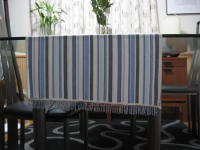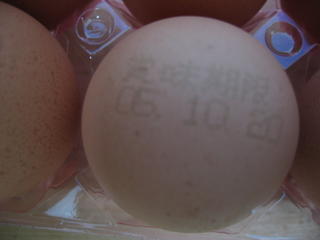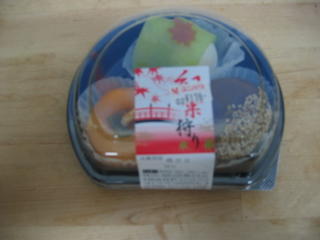
A picture postcard for Halloween, courtesy of Seto Sensei.

とふのかどにあたまをうつけてしねえ
Romanji: tofu no kado ni atama wo utsukete shinee
Word for Word: tofu of corner on head bumped die
Proper English: If you bumped your head on the corner of a piece of tofu, you would die.
The Gist: You're softheaded/stupid.
It's a Japanese insult. I think it's funny, even if you don't.
 Chris was tired of his longish orange hair. What, it doesn't look orange? Are you sure?
Chris was tired of his longish orange hair. What, it doesn't look orange? Are you sure? So he had a very nice Japanese barber give him a haircut. Chris said when the barber started, he looked at Chris' hair and said "Goodbye." A lot of hair was on the floor by the end of the process. When Chris left the shop, the barber told him "Don't catch a cold!"
So he had a very nice Japanese barber give him a haircut. Chris said when the barber started, he looked at Chris' hair and said "Goodbye." A lot of hair was on the floor by the end of the process. When Chris left the shop, the barber told him "Don't catch a cold!"
 Look! It's box with a giant white @$$! No, wait, it's actually the trademark for Momo (peach) Brand matches.
Look! It's box with a giant white @$$! No, wait, it's actually the trademark for Momo (peach) Brand matches. The day we were at the ASPAM, there was a live performance of Shamisen (a three-stringed instrument similar to a Banjo). We enjoyed the music for a little bit and then went to the shops. The ASPAM building is a tourist center, so there's lots of little shops and a couple displays. Most of the shops sell regional specialities. Aomori is famous throughout Japan for its Ringo (apples) and Hotate (scallops) so the shops had a lot of those items, as well as bottles of locally-brewed sake.
The day we were at the ASPAM, there was a live performance of Shamisen (a three-stringed instrument similar to a Banjo). We enjoyed the music for a little bit and then went to the shops. The ASPAM building is a tourist center, so there's lots of little shops and a couple displays. Most of the shops sell regional specialities. Aomori is famous throughout Japan for its Ringo (apples) and Hotate (scallops) so the shops had a lot of those items, as well as bottles of locally-brewed sake.long walks in lowell
the past wanders around in skirts
i scrape your name onto a wall
and find our stories in flaking paint
love can rust
can taste like mildew
love leaks. as a tricycle
it rolled all crooked
i rode the luck of love
up around the leidseplein
the problem with philosophy
is it obscures real things,
sometimes. it blurs the images
i want, paint perfect sharp
refractions of whats happening
i want to see the zits, the coughs
and laughs, the blend of sun
light onto horizon
i dont have any perfect maps
weaving our friendship through the streets
but every place i knew was where
the tourists went
insignificances crowd the path
i put my organs on display
for you. i cut my tongue,
braced for heart ache
i monologue my fears
the air is cool where you look at me
ive read the gourmet recipes
for love pate, lovestuffed pheasant,
dressed and battered love
and tried them out
im sick with them
ive wandered with you
through a couple continents
but dont know where youve gone
 In my meal, I had a half of an enormous and super-fresh green bell pepper, two piimon (japanese peppers), a slice of imo (sweet potato) a shiso leaf, a shiitake kinoko (mushroom), a cluster of shimeji kinoko (also mushrooms), a huge slice of kabocha (Japanese pumpkin-similar to an acorn squash). There was take oshinko (bamboo pickles) and the green mystery pickles that Chris and I both love. Chris is picky about pickles and there's not many he likes so he was happy to see that one of the two pickle dishes with his meal were the GMP's. I got his serving of take oshinko--SCORE!
In my meal, I had a half of an enormous and super-fresh green bell pepper, two piimon (japanese peppers), a slice of imo (sweet potato) a shiso leaf, a shiitake kinoko (mushroom), a cluster of shimeji kinoko (also mushrooms), a huge slice of kabocha (Japanese pumpkin-similar to an acorn squash). There was take oshinko (bamboo pickles) and the green mystery pickles that Chris and I both love. Chris is picky about pickles and there's not many he likes so he was happy to see that one of the two pickle dishes with his meal were the GMP's. I got his serving of take oshinko--SCORE!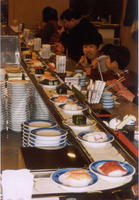 You have a little station at which you sit, and it has soy sauce saucers, Waribashi (disposable chopsticks), a box of Gari (pickled ginger for cleansing the palate), tea cups, and Ocha (tea). Drink all the Ocha you want, it is free! Each station at the counter has its own spigot, which dispenses scalding hot water. See?
You have a little station at which you sit, and it has soy sauce saucers, Waribashi (disposable chopsticks), a box of Gari (pickled ginger for cleansing the palate), tea cups, and Ocha (tea). Drink all the Ocha you want, it is free! Each station at the counter has its own spigot, which dispenses scalding hot water. See? As the different-colored (pay attention to this part) dishes roll by, you take what you like or you can order dishes which are not available on the belt. There are usually daily specials, usually featuring a seasonal food, in addition to the regular menu items.
As the different-colored (pay attention to this part) dishes roll by, you take what you like or you can order dishes which are not available on the belt. There are usually daily specials, usually featuring a seasonal food, in addition to the regular menu items. Well, they have Kappa (cucumber) and Kanpyo (gourd) and Takenoko (bamboo), as well as Tamago(an omelette-like affair) and right now, in Misawa, the larger of the two Pink Sushi shops have this amazing pickled eggplant. (I had four plates/eight pieces of it tonight). I also get Anti-Atkins Sushi (they don't call it that, I do), which is corn mixed with a little mayo served on a pat of rice and wrapped with Nori (seaweed) in the Gunkan (warship) style of sushi. Over there to the left is an example of Gunkan Sushi. It contains Ikura (roe) instead of corn salad, but you get the idea, don't you?
Well, they have Kappa (cucumber) and Kanpyo (gourd) and Takenoko (bamboo), as well as Tamago(an omelette-like affair) and right now, in Misawa, the larger of the two Pink Sushi shops have this amazing pickled eggplant. (I had four plates/eight pieces of it tonight). I also get Anti-Atkins Sushi (they don't call it that, I do), which is corn mixed with a little mayo served on a pat of rice and wrapped with Nori (seaweed) in the Gunkan (warship) style of sushi. Over there to the left is an example of Gunkan Sushi. It contains Ikura (roe) instead of corn salad, but you get the idea, don't you? uffed with rice. The tofu pocket is slightly sweet and sticky and they are oishii (delicious). Sometimes, they sprinkle Goma (sesame seeds) throughout the rice filling, which is great for me, since I am rather fond of sesame. Inari, by the way, is also a Shinto deity, and is the god of rice. His totem animal is the Kitsune (fox). I've seen Wakame (seaweed) chopped up and used in the filling, too, and sometimes Chris has seen Inari with shreds of pork in (I avoid those). I like to stuff the whole Inari in my mouth at once. It makes me look like a chipmunk but for some reason it makes the Inari taste even better.
uffed with rice. The tofu pocket is slightly sweet and sticky and they are oishii (delicious). Sometimes, they sprinkle Goma (sesame seeds) throughout the rice filling, which is great for me, since I am rather fond of sesame. Inari, by the way, is also a Shinto deity, and is the god of rice. His totem animal is the Kitsune (fox). I've seen Wakame (seaweed) chopped up and used in the filling, too, and sometimes Chris has seen Inari with shreds of pork in (I avoid those). I like to stuff the whole Inari in my mouth at once. It makes me look like a chipmunk but for some reason it makes the Inari taste even better.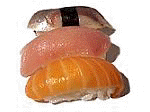 this style, although the Kanpyo and Kappa come in the Hosomaki or
this style, although the Kanpyo and Kappa come in the Hosomaki or Norimaki (roll) style. I've never seen the "inside out" rolls served at Pink Sushi or at any of the other places in Japan where I have dined. I did see them at a lot of places back in the United States, though. Chris also digs Pink Sushi's Karaage (fried chicken). One of the first times we went to Pink Sushi, Chris inadvertently tried horsemeat, mistaking it for prosciutto (he won't make that mistake again). The Tohoku region (where we live) is renowned for its horses which are descendants of a herd established by a local nobleman. Beautiful animals and apparently pretty tasty, as well.
Norimaki (roll) style. I've never seen the "inside out" rolls served at Pink Sushi or at any of the other places in Japan where I have dined. I did see them at a lot of places back in the United States, though. Chris also digs Pink Sushi's Karaage (fried chicken). One of the first times we went to Pink Sushi, Chris inadvertently tried horsemeat, mistaking it for prosciutto (he won't make that mistake again). The Tohoku region (where we live) is renowned for its horses which are descendants of a herd established by a local nobleman. Beautiful animals and apparently pretty tasty, as well.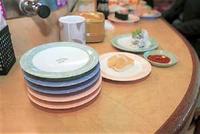 o the bill because traditionally, sushi chefs never handle money (it's dirty and it distracts from their main duty of making the sushi). Did you pay attention at the beginning of the entry, when I told you to? Basically, the number of plates is counted to determine the cost. Before the lady (most of the employees at Pink Sushi are women) counts up the plates, you can tell her "Issho Ni" (all together) or Betsu Betsu (separate) for the check(s). She then counts the dishes, ticks off the appropriate boxes on the check slip, recounts the plates to verify her results and hands you the check with a thank you and a bow. You take the check up front to pay, because in restaurants in Japan, you don't pay at the table--and you don't tip, either. I do however like to tell the Sushi Chef "Arigato, oshiikata deshita" (Thank you, it was delicious). It always makes them smile.
o the bill because traditionally, sushi chefs never handle money (it's dirty and it distracts from their main duty of making the sushi). Did you pay attention at the beginning of the entry, when I told you to? Basically, the number of plates is counted to determine the cost. Before the lady (most of the employees at Pink Sushi are women) counts up the plates, you can tell her "Issho Ni" (all together) or Betsu Betsu (separate) for the check(s). She then counts the dishes, ticks off the appropriate boxes on the check slip, recounts the plates to verify her results and hands you the check with a thank you and a bow. You take the check up front to pay, because in restaurants in Japan, you don't pay at the table--and you don't tip, either. I do however like to tell the Sushi Chef "Arigato, oshiikata deshita" (Thank you, it was delicious). It always makes them smile. prefers capellini and other thin noodles. When I first got here, I wouldn't eat udon noodles, because they reminded me of albino nightcrawlers. I'm glad I got over that stupid hangup, because udon noodles are delicious. There are lots of variations, with just a few listed here: Kamaage tsukejiri (boiled in plain water, accompanied by a strong dipping sauce served on the side), Kitsune, which is Udon with piece of fried tofu on top--probably my favorite. It is said that the Kitsune (Japanese Fox) loves fried tofu, and it is from this story that the dish derives its name; Torroro (Japanese Yam), Yasaiten (a piece of veggie tempura in the bowl), Sansai (Wild Mountain Veggies) and assorted meat ingredients. Chris, having more of a carnivorious nature, likes the Nikku Udon (pork bowl). Udon dishes can be eaten hot or cold. I like the cold noodles for dinner at the end of a hot, humid high summer day. As the weather gets colder, a hot bowl of noodles is an uncomplicated, comforting and filling food.
prefers capellini and other thin noodles. When I first got here, I wouldn't eat udon noodles, because they reminded me of albino nightcrawlers. I'm glad I got over that stupid hangup, because udon noodles are delicious. There are lots of variations, with just a few listed here: Kamaage tsukejiri (boiled in plain water, accompanied by a strong dipping sauce served on the side), Kitsune, which is Udon with piece of fried tofu on top--probably my favorite. It is said that the Kitsune (Japanese Fox) loves fried tofu, and it is from this story that the dish derives its name; Torroro (Japanese Yam), Yasaiten (a piece of veggie tempura in the bowl), Sansai (Wild Mountain Veggies) and assorted meat ingredients. Chris, having more of a carnivorious nature, likes the Nikku Udon (pork bowl). Udon dishes can be eaten hot or cold. I like the cold noodles for dinner at the end of a hot, humid high summer day. As the weather gets colder, a hot bowl of noodles is an uncomplicated, comforting and filling food.
 And here it is! A giant stuffed maru nasu (Japanese Round Eggplant). I was even more excited to discover the thing was on sale for more than half off! No wonder, who the hell would buy a giant plush eggplant. Uh...yeah...anyway...Here's the maru nasu, sitting in the middle of my den.
And here it is! A giant stuffed maru nasu (Japanese Round Eggplant). I was even more excited to discover the thing was on sale for more than half off! No wonder, who the hell would buy a giant plush eggplant. Uh...yeah...anyway...Here's the maru nasu, sitting in the middle of my den. I nearly peed myself laughing. It is the only way both cookie humpers, er, cutters will fit, but still! Of course, I had to buy them, so I could come home, take a picture of it and post it to the blog. Hey, I never promised you Pulitzer-quality E-Literature, now did I?
I nearly peed myself laughing. It is the only way both cookie humpers, er, cutters will fit, but still! Of course, I had to buy them, so I could come home, take a picture of it and post it to the blog. Hey, I never promised you Pulitzer-quality E-Literature, now did I? 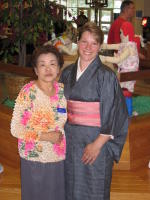 and sweet and she is extremely outgoing, which is a bit unusual in a Japanese person, especially an older one. She and her family run Aizawa Costume shop, where they provide rental kimono for weddings, funerals and other formal occassions. Eiko-san is a licensed, professional kimono dresser (this entails formal study and passing a practical exam or exams). Many Japanese rent kimono for such occassions, since a bridal kimono and all the accessories cost several thousand dollars. Yes, several thousand. Eiko-san has been very gracious and generous in teaching me how to wear kimono. Many Japanese cannot dress themselves in kimono and have to pay a professonal like Eiko-san to dress them. Some attend Kimono Schools to learn how to dress in kimono. There are several such Kimono Schools in Misawa and I don't think they are cheap. Eiko-san shows me for free and she buys me coffee. In exchange, I buy ridiculous numbers of kimono, so it works out well for both of us. We've become friends, despite her limited English (No! No! No! Wrong!) and my limited Japanese (Hai, Hai, Hai, Moiikai--Yes, yes, yes, I will do it over).
and sweet and she is extremely outgoing, which is a bit unusual in a Japanese person, especially an older one. She and her family run Aizawa Costume shop, where they provide rental kimono for weddings, funerals and other formal occassions. Eiko-san is a licensed, professional kimono dresser (this entails formal study and passing a practical exam or exams). Many Japanese rent kimono for such occassions, since a bridal kimono and all the accessories cost several thousand dollars. Yes, several thousand. Eiko-san has been very gracious and generous in teaching me how to wear kimono. Many Japanese cannot dress themselves in kimono and have to pay a professonal like Eiko-san to dress them. Some attend Kimono Schools to learn how to dress in kimono. There are several such Kimono Schools in Misawa and I don't think they are cheap. Eiko-san shows me for free and she buys me coffee. In exchange, I buy ridiculous numbers of kimono, so it works out well for both of us. We've become friends, despite her limited English (No! No! No! Wrong!) and my limited Japanese (Hai, Hai, Hai, Moiikai--Yes, yes, yes, I will do it over).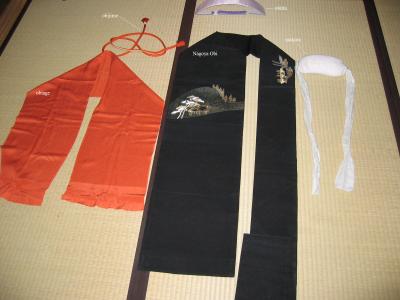
 The obiita goes on. I have a kantan (easy) one, it has an elastic band. Some obiita are just boards without the band; you stick them into the obi after you do the first wrap around your waist.
The obiita goes on. I have a kantan (easy) one, it has an elastic band. Some obiita are just boards without the band; you stick them into the obi after you do the first wrap around your waist. Then I drape the short section (te) over the left shoulder from back to front.
Then I drape the short section (te) over the left shoulder from back to front. The long section (tare) of the obi is wrapped around the waist twice. Because this obi has a decorated tare, I have to ensure the decoration is nicely centered.
The long section (tare) of the obi is wrapped around the waist twice. Because this obi has a decorated tare, I have to ensure the decoration is nicely centered.
 Next, tie the obi and allow the tail section to drop down
Next, tie the obi and allow the tail section to drop down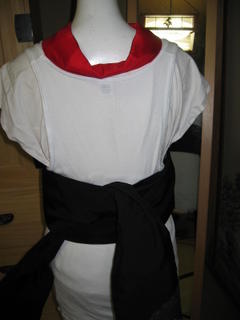 Then you pull the bow part out and smooth out the gathers from the knot
Then you pull the bow part out and smooth out the gathers from the knot You pick up the wide part and fold it, making sure that if there is a design, it is centered
You pick up the wide part and fold it, making sure that if there is a design, it is centered Then you insert the makura under the top fold and fasten it around the waist
Then you insert the makura under the top fold and fasten it around the waist
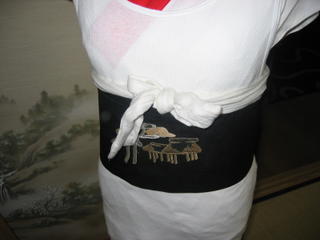 Tuck the ties into the obi
Tuck the ties into the obi Here is another view of what we have so far
Here is another view of what we have so far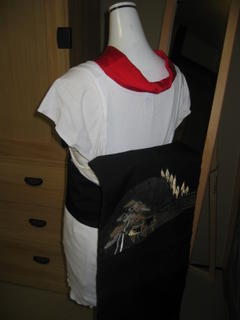 Cover the makura with the obiage, wrap around and tie in a temporary knot in front
Cover the makura with the obiage, wrap around and tie in a temporary knot in front
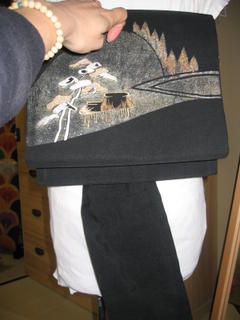
 Now you pass the te through the drum,
Now you pass the te through the drum,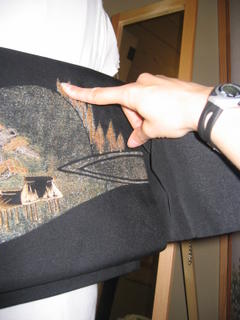

 Tie it with a fancy knot, dumbass!
Tie it with a fancy knot, dumbass!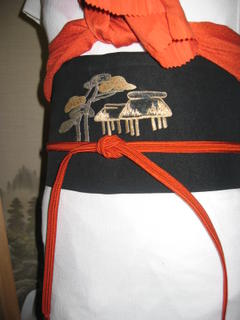 Adjust the obi and bow so that it has a lays flat and looks crisp,
Adjust the obi and bow so that it has a lays flat and looks crisp,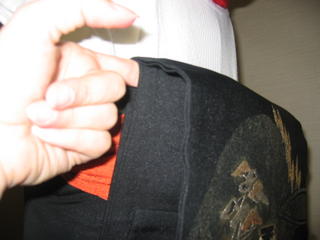 Untie the temporary knot you made in the obiage, fold the edges in,
Untie the temporary knot you made in the obiage, fold the edges in, Adjust the knot until it looks just so and then tuck all of the obiage down into the obi
Adjust the knot until it looks just so and then tuck all of the obiage down into the obi Loop the loose ends of the obijime back into the obijime and
Loop the loose ends of the obijime back into the obijime and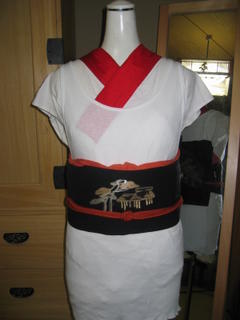 Admire the back
Admire the back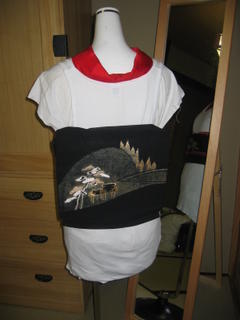 Realize there are ninety gazillion things wrong with this and take it all off and try again
Realize there are ninety gazillion things wrong with this and take it all off and try again

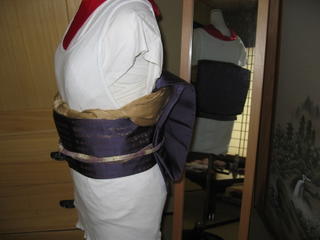
 How sweet was that? Sylvia is a wonderful co-worker and a great friend. She is funny and smart and sweet and loving and goes "Ha. ha. ha." when she laughs. Sylvia is a nice shade of brown, too.
How sweet was that? Sylvia is a wonderful co-worker and a great friend. She is funny and smart and sweet and loving and goes "Ha. ha. ha." when she laughs. Sylvia is a nice shade of brown, too.